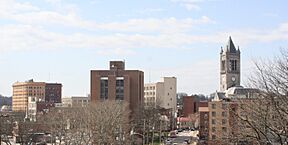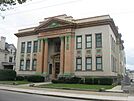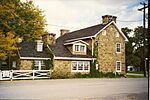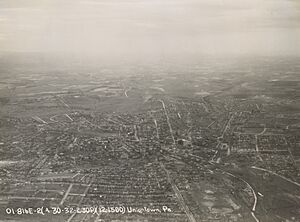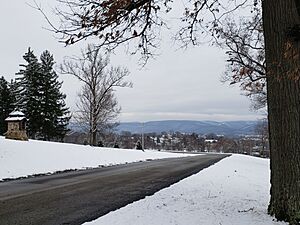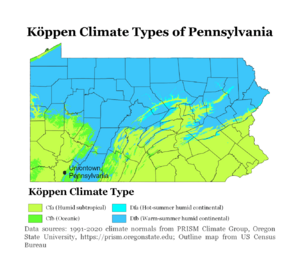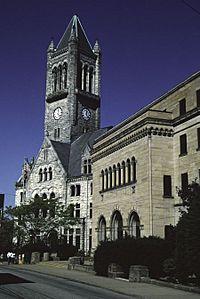Uniontown, Pennsylvania facts for kids
Quick facts for kids
Uniontown, Pennsylvania
|
|
|---|---|
|
|
|
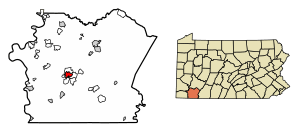
Location of Uniontown in Fayette County, Pennsylvania.
|
|
| Country | United States |
| State | Pennsylvania |
| County | Fayette |
| Established | July 4, 1776 |
| Area | |
| • Total | 2.05 sq mi (5.32 km2) |
| • Land | 2.05 sq mi (5.32 km2) |
| • Water | 0.00 sq mi (0.00 km2) |
| Elevation | 999 ft (304 m) |
| Population
(2020)
|
|
| • Total | 9,984 |
| • Density | 4,731.74/sq mi (1,827.24/km2) |
| Time zone | UTC−5 (EST) |
| • Summer (DST) | UTC−4 (EDT) |
| ZIP Code |
15401
|
| Area code(s) | 724, 878 |
| FIPS code | 42-78528 |
Uniontown is the biggest city in Fayette County, Pennsylvania. It's also the county seat, which means it's where the main government offices are. The city is about 40 miles (64 km) southeast of Pittsburgh. In 2020, about 9,984 people lived there. Uniontown is part of the larger Pittsburgh metropolitan area.
Contents
Uniontown's Early History
About 10 miles (16 km) southeast of Uniontown is Fort Necessity. This fort was built by George Washington during the French and Indian War. This war was a big conflict that started in North America. The Battle of Jumonville Glen, where the war began, also happened nearby.
Uniontown was started on July 4, 1776, by a man named Henry Beeson. He was a Quaker from Virginia. He had moved to the area in 1768 and bought a lot of land. He also ran a sawmill. On the same day the United States Declaration of Independence was adopted, Beeson announced plans for quarter-acre plots of land. People could buy these plots and build houses on them.
In its early days, some people unofficially called the town "Beesonstown." In 1783, Fayette County was created. Uniontown became an official borough in 1796. It was named Uniontown and separated from Union Township.
Growth and Important Roads
The National Road, also known as the Cumberland Road, was built through Uniontown in the early 1800s. This road helped the town grow a lot. Today, this road is known as US 40.
Uniontown also played a role in the Underground Railroad. This was a secret network that helped slaves escape from the South to freedom before the Civil War. There's a special marker in town to remember this history.
Coal, Steel, and Millionaires
In the late 1800s, Uniontown grew because of coal mines and the steel industry. There were some tough times, like during the bituminous coal miners' strike of 1894. During this strike, there were clashes between coal miners and guards.
The Columbia Rolling Mill, which made iron and steel, was a major industry in Uniontown from 1887 to 1895. During the "Coal Boom" in the early 1900s, Uniontown was home to many millionaires. It had more millionaires per person than almost any other city in the United States! These wealthy "coal barons" even helped fund the famous Uniontown Speedway, a mile-and-a-quarter racetrack, from 1916 to 1922.
Changes Over Time
Like many places in Western Pennsylvania, Uniontown's economy slowed down in the late 1900s. This was because the steel industry changed, and many jobs moved away. This decline continued into the 2000s, and the city's population is now about half of what it was in 1940.
The United States Navy once had a ship named after the city. It was called USS Uniontown.
In 1967, Uniontown was the birthplace of the famous McDonald's Big Mac sandwich! Later, a Big Mac Museum opened in another town, which made some Uniontown residents a bit disappointed.
Several historic places in Uniontown are listed on the National Register of Historic Places. These include the Uniontown Downtown Historic District, Gallatin School, John S. Douglas House, John P. Conn House, and Adam Clarke Nutt Mansion.
Uniontown's Geography
Uniontown is located in Fayette County, Pennsylvania. It's about 12 miles (19 km) north of the West Virginia state line.
The city covers about 2.05 square miles (5.32 km2) of land. It sits about 999 feet (304 m) above sea level. Uniontown is at the base of Chestnut Ridge. This is the westernmost ridge of the Appalachian Mountains to the east. The historic National Pike, or Cumberland Road, crossed these mountains and went right through the center of Uniontown. Today, this route is Business Route 40. The main US 40 now goes around the city center as a freeway loop called the George Marshall Parkway.
Climate and Weather
Uniontown has a climate that's a mix of two types: a humid continental climate and a humid subtropical climate. This means it has cold winters, with temperatures often between 30s and 40s °F (0–10 °C). Summers are warm to hot and humid, with temperatures usually in the 70s to 80s °F (20–30 °C).
| Climate data for Uniontown, Pennsylvania (1991–2020; extremes 1974–present | |||||||||||||
|---|---|---|---|---|---|---|---|---|---|---|---|---|---|
| Month | Jan | Feb | Mar | Apr | May | Jun | Jul | Aug | Sep | Oct | Nov | Dec | Year |
| Record high °F (°C) | 79 (26) |
77 (25) |
88 (31) |
93 (34) |
93 (34) |
97 (36) |
102 (39) |
102 (39) |
99 (37) |
95 (35) |
88 (31) |
77 (25) |
102 (39) |
| Mean daily maximum °F (°C) | 39 (4) |
42 (6) |
51 (11) |
63 (17) |
72 (22) |
80 (27) |
84 (29) |
83 (28) |
76 (24) |
65 (18) |
54 (12) |
42 (6) |
63 (17) |
| Daily mean °F (°C) | 31 (−1) |
33 (1) |
42 (6) |
53 (12) |
62 (17) |
70 (21) |
73 (23) |
72 (22) |
65 (18) |
54 (12) |
45 (7) |
35 (2) |
53 (12) |
| Mean daily minimum °F (°C) | 20 (−7) |
22 (−6) |
28 (−2) |
37 (3) |
46 (8) |
56 (13) |
60 (16) |
59 (15) |
51 (11) |
40 (4) |
32 (0) |
24 (−4) |
40 (4) |
| Record low °F (°C) | −22 (−30) |
−16 (−27) |
−3 (−19) |
15 (−9) |
23 (−5) |
33 (1) |
37 (3) |
34 (1) |
29 (−2) |
16 (−9) |
−1 (−18) |
−14 (−26) |
−22 (−30) |
| Average precipitation inches (mm) | 3.10 (79) |
2.79 (71) |
3.67 (93) |
3.68 (93) |
4.46 (113) |
4.26 (108) |
4.57 (116) |
3.52 (89) |
3.35 (85) |
2.98 (76) |
3.66 (93) |
3.07 (78) |
43.11 (1,094) |
| Average snowfall inches (cm) | 8.4 (21) |
7.2 (18) |
4.6 (12) |
0.4 (1.0) |
0.0 (0.0) |
0.0 (0.0) |
0.0 (0.0) |
0.0 (0.0) |
0.0 (0.0) |
0.0 (0.0) |
0.9 (2.3) |
4.4 (11) |
25.9 (65.3) |
| Source: NWS Pittsburgh - NOWData / XMACIS | |||||||||||||
People Living in Uniontown
| Historical population | |||
|---|---|---|---|
| Census | Pop. | %± | |
| 1800 | 624 | — | |
| 1810 | 999 | 60.1% | |
| 1820 | 1,058 | 5.9% | |
| 1840 | 1,710 | — | |
| 1850 | 2,333 | 36.4% | |
| 1870 | 2,503 | — | |
| 1880 | 3,265 | 30.4% | |
| 1890 | 6,359 | 94.8% | |
| 1900 | 7,344 | 15.5% | |
| 1910 | 13,344 | 81.7% | |
| 1920 | 15,692 | 17.6% | |
| 1930 | 19,544 | 24.5% | |
| 1940 | 21,819 | 11.6% | |
| 1950 | 20,471 | −6.2% | |
| 1960 | 17,942 | −12.4% | |
| 1970 | 16,282 | −9.3% | |
| 1980 | 14,510 | −10.9% | |
| 1990 | 12,034 | −17.1% | |
| 2000 | 12,422 | 3.2% | |
| 2010 | 10,372 | −16.5% | |
| 2020 | 9,984 | −3.7% | |
| Sources: | |||
In 2010, there were 10,372 people living in Uniontown. These people lived in 5,423 households. About 3,031 of these were families. The city had about 5,136 people per square mile (1,983 per km2).
Most of the people in Uniontown were White (75.16%). About 18.90% were African American. Other groups included Native American, Asian, and people from two or more races. About 1.59% of the population was Hispanic or Latino.
Many people in Uniontown have German, Irish, Italian, Dutch, English, or Polish backgrounds.
About 23.7% of households had children under 18. About 35.8% were married couples. Around 16.0% were households led by a woman without a husband. About 39.7% of all households were single individuals. The average household had 2.27 people.
The median age in the city was 39 years old. This means half the people were younger than 39 and half were older. For every 100 females, there were about 86 males.
In 2012, the average income for a household in Uniontown was $31,760. For families, it was $37,841. The average income per person in the city was $22,457.
Education in Uniontown
Uniontown is part of the Uniontown Area School District. This district includes several schools:
- Lafayette Elementary School (grades K–5)
- Menallen Elementary School (grades K–6)
- Ben Franklin Elementary/Middle School (grades K–8)
- Lafayette Middle School (grades 6–8)
- Uniontown Area High School (grades 9–12)
Students can also go to the Fayette County Career and Technical Institute. Here, they can learn skills for different jobs. The Laurel Highlands School District serves areas just outside the city.
There are also private schools like St. John the Evangelist Regional Catholic School and Chestnut Ridge Christian Academy.
For higher education, Uniontown has the Westmoreland County Community College Uniontown Education Center, Penn State Fayette, Laurel Business Institute, and United Career Institute. A long time ago, from 1827 to 1857, Uniontown was home to Madison College.
City Services
Uniontown Hospital is the biggest hospital in Fayette County. It's also the largest employer in the city.
The City of Uniontown has its own full-time police department. The police station also has a special center where all police agencies in Fayette County, including the Pennsylvania State Police, can book people.
The Uniontown Bureau of Fire is a team of both paid and volunteer firefighters. They work from three stations. They put out fires, help prevent them, and do various rescue operations. They also help with disaster planning and response.
The fire department has four fire engines, two ladder trucks, a heavy rescue unit, a squad truck, and a command SUV. Their main station, Central Station, is downtown. It also houses two Fayette EMS units. The East End Station is on Connellsville Street. The third station, the Union Hose Building, is on East Main Street. It houses the city's Emergency Management Agency and a reserve fire engine.
Media and News
- The Herald-Standard is a newspaper based in Uniontown. It covers news for the city and the surrounding area.
- Fayette TV offers local TV shows on Breezeline Cable channel 77.
- Two radio stations broadcast in the Uniontown area: WMBS (590 AM, 101.1 FM) and WPKL (99.3 FM).
Getting Around Uniontown
Uniontown is an important place where many roads meet in Fayette County. The main road around town is a freeway bypass called the George Marshall Parkway. This road includes parts of US 40 and US 119.
US 119 comes into the area as a two-lane road from Morgantown, West Virginia. It forms the northern part of the bypass. Then it becomes a four-lane road to Connellsville. US 40 comes into the area as a two-lane road from Brownsville. It forms the southern part of the freeway. After Uniontown, it becomes a mountain road that goes through rural areas and into Maryland, reaching Interstate 68. The older parts of US 40, now called Business 40, go through the downtown area.
PA 51, a main four-lane road to Pittsburgh, ends in Uniontown. PA 21, which connects Fayette County with Greene County and Waynesburg, also ends here. PA 43, which is part of the Mon–Fayette Expressway project, is complete around Uniontown. This project aims to connect Pittsburgh with Morgantown, West Virginia.
Local bus service in Uniontown is provided by Fayette Area Coordinated Transportation.
Famous People from Uniontown
Many notable people have connections to Uniontown:
- Bruiser Brody (Frank Donald Goodish) (1946–1988), a professional wrestler.
- Henry Bidleman Bascom (1796–1850), a religious leader and first president of Madison College.
- Henry White Beeson (1791–1863), a former member of the U.S. House of Representatives.
- John Dickson Carr (1906–1977), a mystery writer born in Uniontown.
- Robert J. Cenker, an engineer and astronaut.
- William E. Crow (1870–1922), a former United States Senator.
- Teresa Abi-Nader Dahlberg (born 1961), an academic leader and engineering professor.
- Ernie Davis (1939–1963), the first African-American Heisman Trophy winner, lived in Uniontown for much of his early life.
- John Littleton Dawson (1813–1870), a former member of the U.S. House of Representatives.
- Jim Delligatti (1918–2016), the person who invented the Big Mac.
- Tory Epps (1976–2005), a former NFL defensive lineman.
- Mark Esper (born 1964), the 27th United States Secretary of Defense.
- George Bird Evans (1906–1998), a famous illustrator and writer.
- Ronne Froman (born 1947), a retired U.S. Navy Rear Admiral.
- Gus Gerard (born 1953), a former ABA and NBA basketball player.
- Thomas Irwin (1785–1870), a former member of the U.S. House of Representatives.
- William James (born 1979), a former NFL cornerback.
- Stu Lantz (born 1946), a former NBA player and current commentator for the Los Angeles Lakers. He led Uniontown High School to a state championship in 1964.
- James Lawson (born 1928), a civil rights leader.
- George C. Marshall (1880–1959), a famous American military leader and Secretary of State.
- Terry Mulholland (born 1963), a former Major League baseball player.
- Chuck Muncie (1953–2013), a former NFL running back.
- Nelson Munsey (1948–2009), a former NFL cornerback.
- David Nehls (born 1964), an actor, singer, and composer.
- Larry Pennell (1928–2013), an actor.
- Kaleb Ramsey (born 1989), a former NFL player.
- Wil Robinson (born 1949), a former NBA/ABA player.
- Sandy Stephens (1940–2000), the first African-American quarterback for the University of Minnesota Golden Gophers.
- Andrew Stewart (1791–1872), a former member of the U.S. House of Representatives.
- Daniel Sturgeon (1789–1878), a former United States Senator.
- Tom Wilson (1931–2011), the cartoonist who created the Ziggy comic strip.
- Gene Steratore (born 1963), a former NFL football and NCAA basketball referee.
- Gene Huey (born 1947), a former AFL football player and coach.
- Thomas Ford (1800-1850), the 8th Governor of Illinois.
|
See also
 In Spanish: Uniontown (Pensilvania) para niños
In Spanish: Uniontown (Pensilvania) para niños


